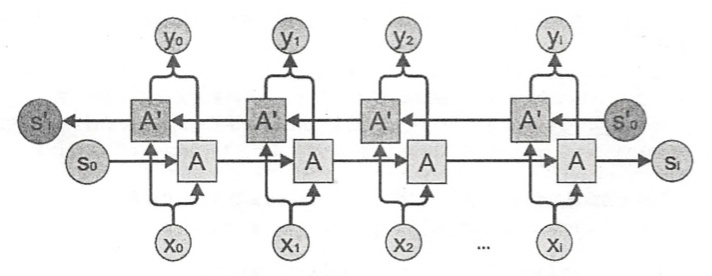1、输入input:数据维度是 (seq, batch, feature),即序列长度、batch_size、每个时刻特征数量。
2、output, (hn, cn) = nn.LSTM(input_size, hidden_size, num_layers)
input_size:每时刻输入特征数量
hidden_size:隐藏层特征数量,决定着输出每一时刻的特征维度
num_layers:隐藏层数量
output:输出结果,维度为(seq, batch_size,hidden_size),相比于输入而言,输出的时间长度和batch_size都不变,只有特征维度发生变化,与设置的隐藏状态数一致。
hn:最后一个时刻的隐藏状态,每一层都会有一个最后时刻的隐藏状态,因此它的维度为(num_layers,batch_size,hidden_size)。
cn:最后一个时刻的记忆单元状态,每一层都会有一个最后时刻的状态,因此它的维度也为(num_layers,batch_size,hidden_size)。
关于output和hn,output为最后一层所有时刻的隐藏状态输出,而hn为最后一个时刻的所有层的隐藏状态输出。因此,可以得到output[-1] = hn[-1]。
3、注意事项,与CNN不同的是batch_size在中间,而CNN通常Batch_size在第一个维度,可通过batch_first=True设置与CNN保持一致。
5、双向LSTM,设置bidirectional=True。与单向lstm区别在于,output的特征维度增加一倍,维度变为(seq, batch_size,2*hidden_size),层数也相当于增加了一倍,即每一层都会相应增加一层逆向推理的层,那么hn和cn的一个维度加倍,即(2*num_layers,batch_size,hidden_size)。由于双向lstm先从左到右再从右到左,因此hn的输出反而与output的第一个维度相等,output[0,:,hidden_size:] = hn[-1]。

4、示例代码
import numpy as np
from torch import nn
import torch
x = torch.randn(13, 7, 3)#seq length 13, batch size 7, features 3
lstm = nn.LSTM(3, 5, 2)
output, (hn, cn) = lstm(x)
print('input shape: ', x.shape) #13,7,3
print('output shape: ', output.shape) #13,7,5
print('hn shape: ', hn.shape) #2,7,5
print('cn shape: ', cn.shape) #2,7,5
#print(output[-1])
#print(hn[-1])
print(output[-1] == hn[-1]) #True, 二者相等
#batch_first=True
x = torch.randn(13, 7, 3)#seq length 7, batch size 13, features 3
lstm = nn.LSTM(3, 5, 2, batch_first=True) #batch size 13
output, (hn, cn) = lstm(x)
print('input shape: ', x.shape) #13,7,3
print('output shape: ', output.shape) #13,7,5
print('hn shape: ', hn.shape) #2,13,5
print('cn shape: ', cn.shape) #2,13,5
#print(output[:,-1,:]) #在序列维度上的最后一维
#print(hn[-1,])
print(output[:,-1,:] == hn[-1]) #True, 二者相等
#bidirectional=True
x = torch.randn(13, 7, 3)#seq length 13, batch size 7, features 3
lstm = nn.LSTM(3, 5, 2, bidirectional=True)
output, (hn, cn) = lstm(x)
print('input shape: ', x.shape) #13,7,3
print('output shape: ', output.shape) #13,7,10
print('hn shape: ', hn.shape) #4,7,5
print('cn shape: ', cn.shape) #4,7,5
print(output[-1])
print(hn[-1])
print(output[0, :, 5:] == hn[-1]) #True, 二者相等,由于双向lstm先从左到右再从右到左,因此hn的输出反而与output的第一个维度相等。